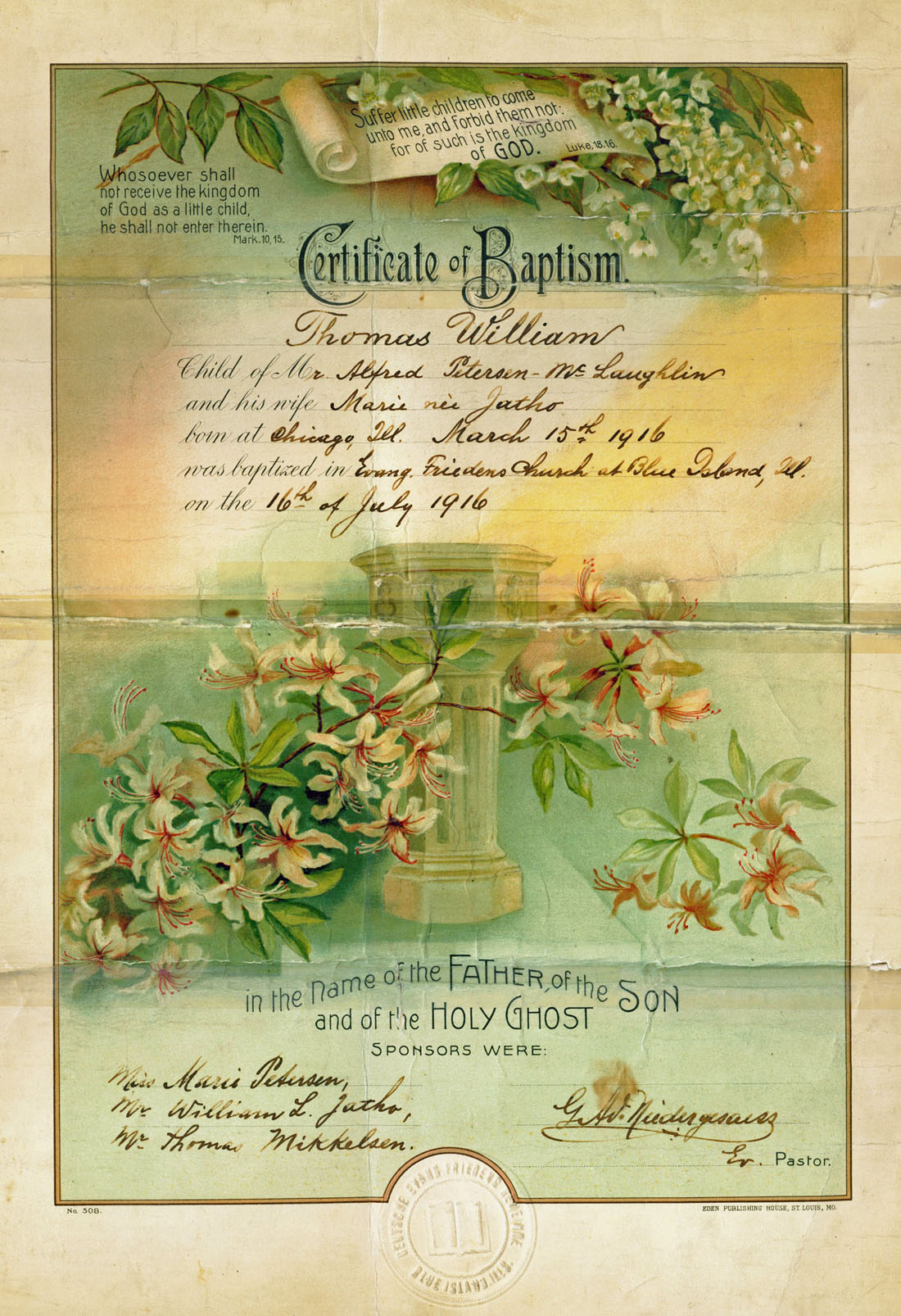Stories
This page will include personal stories and anecdotes about people and relevant documents in our family, based on memories or revelations from those who knew them.
“It is a desirable thing to be well-descended, but the glory belongs to our ancestors. -– Plutarch
Stories are by definition integrated into the memories of the people who relate them to us. They may not always be historically accurate but they reveal how those individuals were seen by others. Such stories are not documentable in the sense of historical documentation, but they provide a flavor otherwise unobtainable by the bare facts.
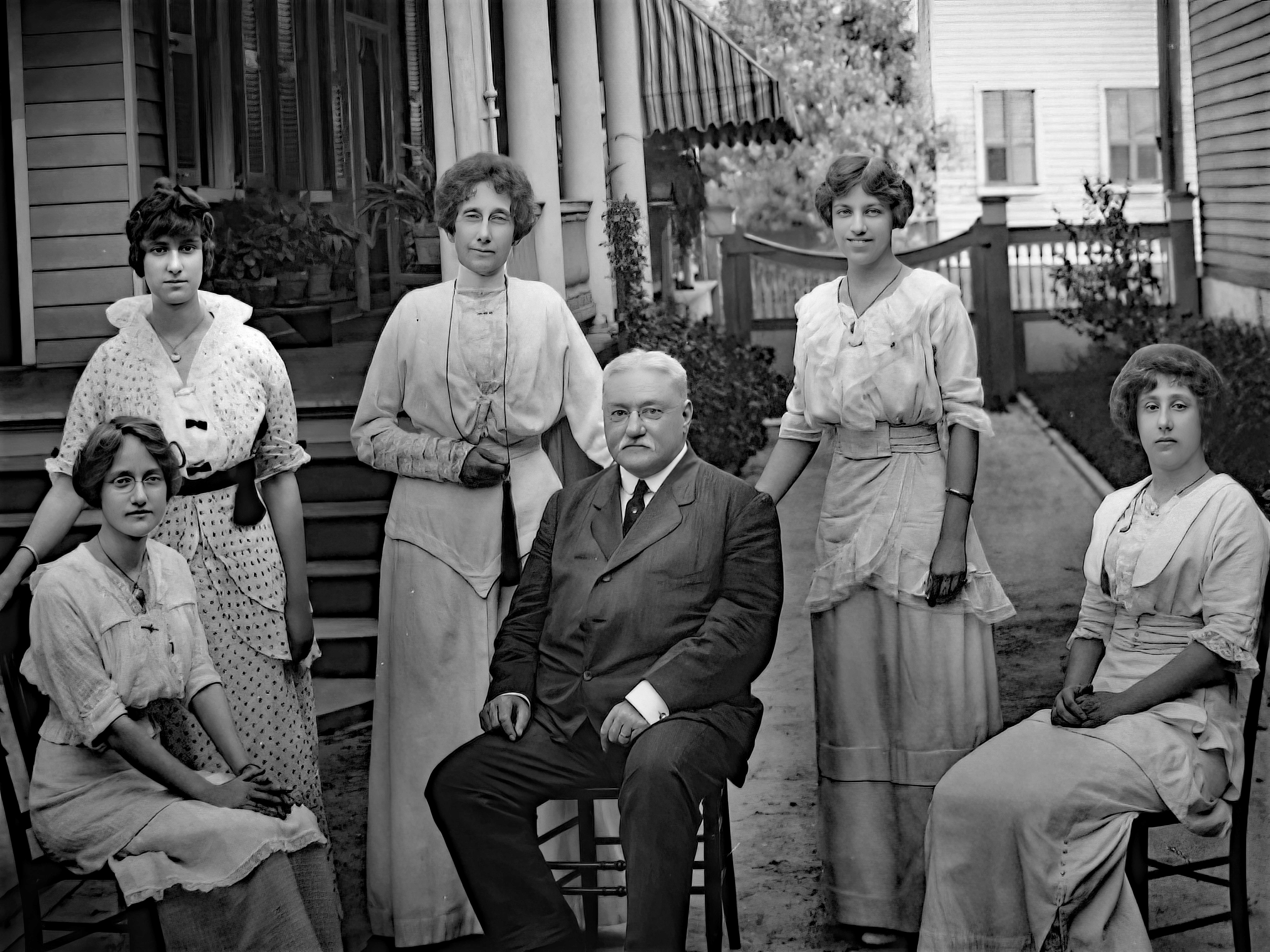
George William Jatho and family, Charleston SC 1910
He was the middle child but ended up being the default patriarch of the Charleston Jatho family. His father, Georg Wilhelm Jatho, a German immigrant, died early at age 46, leaving a widow and seven children. Two brothers and a sister died as well, and two remaining younger brothers had run-ins with the law and had to be propped up, more or less, when they stumbled. George, born in 1856 in Charleston, was the unexpected leader on whom everyone else depended.
George was lucky in love. His wife, Arnolda Cornelia von Oven, was a German immigrant herself, part of a family of siblings who emigrated to Charleston in the 1870s and became well-known merchants, specializing in import groceries and wines. George met Arnolda by chance in an open-air market. She was struggling to remember the English word for cabbage (all she could conjure up was the German word). George supplied the word in English and a romance was born.
After their marriage in 1881 George continued his career as a merchandise broker and eventually worked his way into a sales position at Colgate & Company, the same company known today for its soaps and toothpastes. Their home at 2 Doughty Street in Charleston suggests a certain amount pf prosperity, and this c. 1910 portrait showcases their family. The parents of seven children in all, George and Arnolda lost three very early: Arnolda Pauline, who died at age six months in 1883, Herbert, who died just shy of five years old after a bout with pleurisy in 1889, and baby Ruby, who died in 1889 at the age of six months.
But four daughters thrived into adulthood, as this portrait demonstrates. From left: Maryliese (born in 1886) who married Robert Samuel Tiedeman in 1942; Olga, who married publisher and printer Louis D. Quin; Pauline Marcella, who married William Henry Magwood in 1917; and Georgia, who never married but who left her mark on a number of Charleston charities which consumed her energies until her death in 1942.
George himself was involved in charitable work in Charleston in addition to his sales career. Arnolda died in 1918, George himself in 1924. But the family left its mark on Charleston society well into the twentieth century.
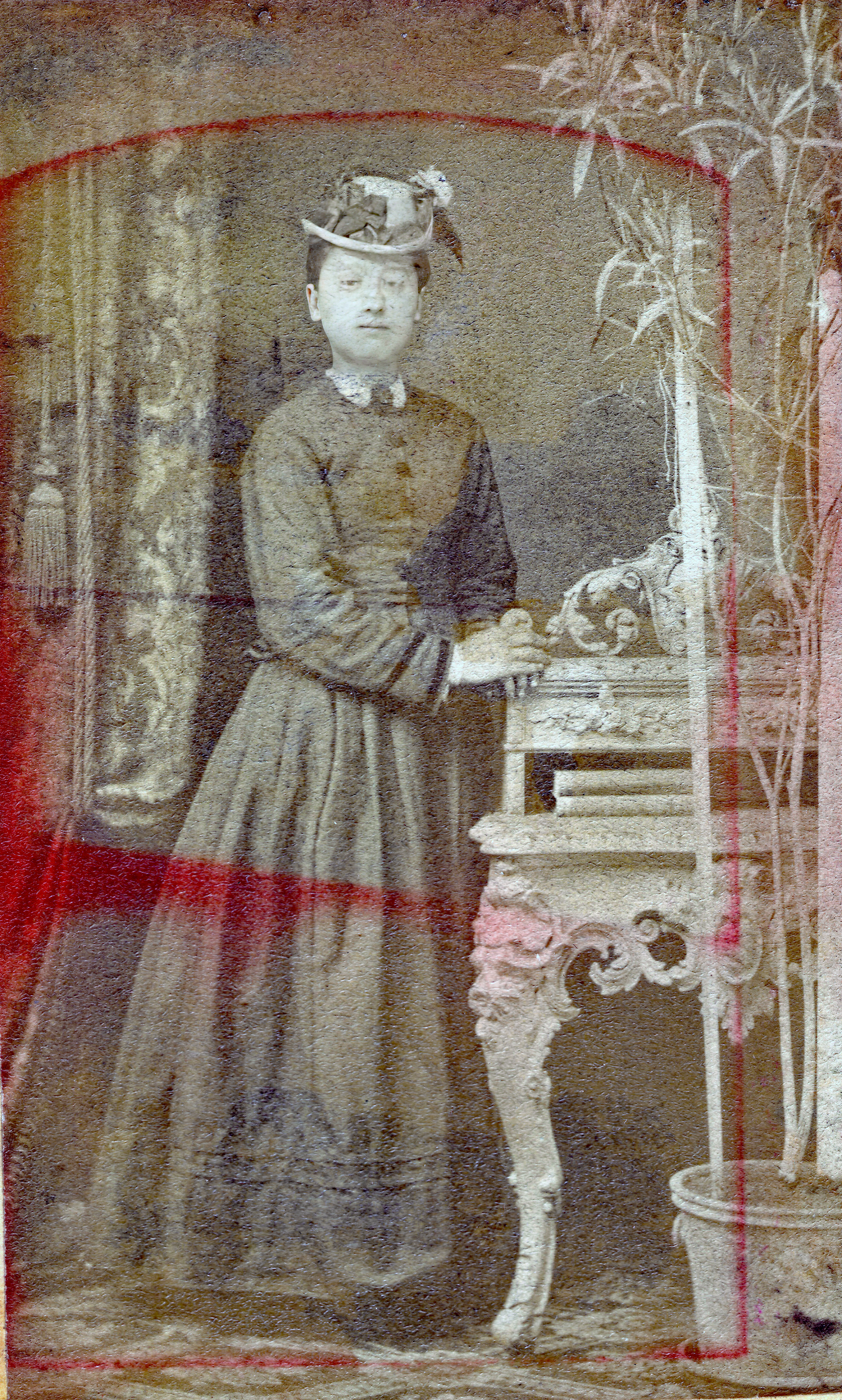
Catharina Maria Petersen
I didn't know her personally but Catharina was the person I most wanted to know. After nearly twenty years I feel that I know some things about her, others I can only imagine.
This portrait, somewhat damaged, was taken in the H.P. Petersen studio in Niebüll, Schleswig-Holstein. He was probably not related, Petersen being a very common patronym (rather than a surname per se) in the region. But Niebüll was a very popular town in the area, just the place for a confirmation photo. Catharina was about fourteen here, stylishly dressed with a be-ribboned and flowered hat. She looks like a girl on the cusp of teenager-hood. Hard to believe that she would be married two years later to her first cousin, Hans Peter Petersen, so enjoying her youth was a fleeting circumstance.
I met Catharina's granddaughter in 2004, who shared many of these family photos with me and talked about her in detail. The basic facts: Catharina lived in Nebraska and Illinois after she and her family emigrated in 1878, married twice (Hans died in 1905, her second husband was Thomas Mikkelsen), had twelve children between two marriages, experienced loss: four children died as infants or toddlers; one daughter, Margaret, died from suicide in 1903 at age fifteen; one son Peter Heinrich died at age 32 of nephritis, another, Louis, died of pneumonia at age 45. It wasn't a particularly unusual circumstance for so many family members to die young before modern medicine and pharmaceuticals were available. But these losses probably shaped her later personality.
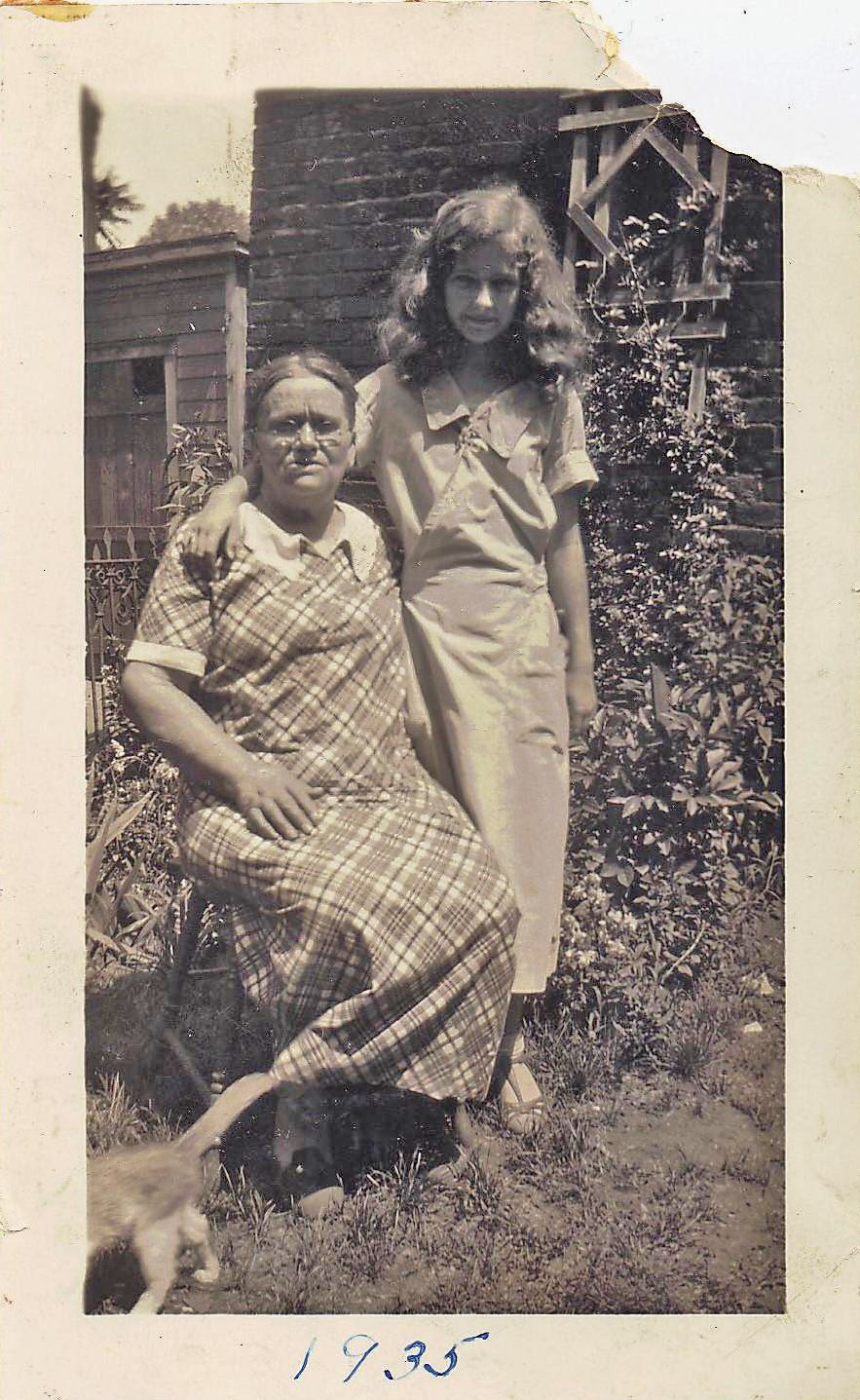
In her later years Catherine was quiet, her granddaughter remembered. She was multilingual; she was fluent in German (as one would expect), which she spoke with her children, as well as English. She spoke Danish when she didn't want her children to understand her (both husbands knew Danish, apparently).
She joked about marrying her first cousin Hans. She thought it was nice that she didn't have to change the embroidered initials on her trousseau. But she confided that perhaps marrying one's first cousin was not necessarily a good idea. Perhaps she blamed her children's health issues (mental and physical) on her close relationship with Hans. Perhaps there were other concerns that she never shared with anyone.
She adored her many grandchildren, most of whom lived in and around Chicago. As a widow (Thomas Mikkelsen died in 1921) she depended on her extended family and likely kept in touch with her only sister, Helene Burmeister, who ran a guest house in Sillerup back in Schleswig. Catherine had a wide coterie of friends, many of whom were captured in family photos (not many of them captioned, alas). Catherine loved cats. A family feline can be seen in this photo from 1935 with her granddaughter Louise, administering a typical tail kiss in the corner of the snapshot.
Catherine died in 1944 at the age of 82. It wasn't until then that her three remaining sons -- Alva (formerly Alfred), George, and Clarence -- left Chicago for points west. Her daughters Marie (from her first marriage) and Florence (from her second) remained in Chicago all their lives.
A few details about a person's life aren't sufficient to paint a complete portrait, but it's a start, and more than we'd have had without her granddaughter's fond memories and the photos that document Catherine's life.
Baptism record, Thomas Petersen-McLaughlin
When my mother handed me this certificate (click to enlarge) in the mid-1980s she had no idea what could be done with it. She just said "Someday you'll want to have this." And she was right, because it was my Rosetta Stone.
Hard to believe that a simple baptism certificate from 1916 could have such power. It wasn't written in three different scripts, like the real Rosetta Stone, but it held the key to translating my own family history, much the way the Rosetta Stone helped philologists translate Demotic and Classical Egyptian. I just had to learn how to decipher what was there.
My father was notoriously secretive about his family background. He couldn't (or wouldn't) tell me his paternal grandparents' names. I asked often but the answers were never forthcoming. He was so uncommunicative that I thought for a long time that I'd been adopted or that my parents were hiding some other secret. Even when I asked about the people whose names appeared on this certificate, I got answers that made no sense, or made minimal sense. "Just family names," I was told.
Of course they were family names, but I had to find out their relevance. Mikkelsen, Jatho, Petersen... just what was this Petersen thing, anyway? And why was my father's name hyphenated when he never used that form of the name?
My dad has been gone for over forty years now and even if he were around it would do no good to ask him -- he wanted this information hidden. At the time he was born Chicago had just started requiring county birth certificates, but my dad and his older sister (born in 1915) had no official birth record. A baptism certificate served for official purposes: marriages (proving date of birth), citizenship (proving place of birth), basic identity. Why no one pointed out that my father's surname was listed as Petersen-McLaughlin (misspelled to boot!) remains a mystery, or as my mother explained it, "It was just a mistake."
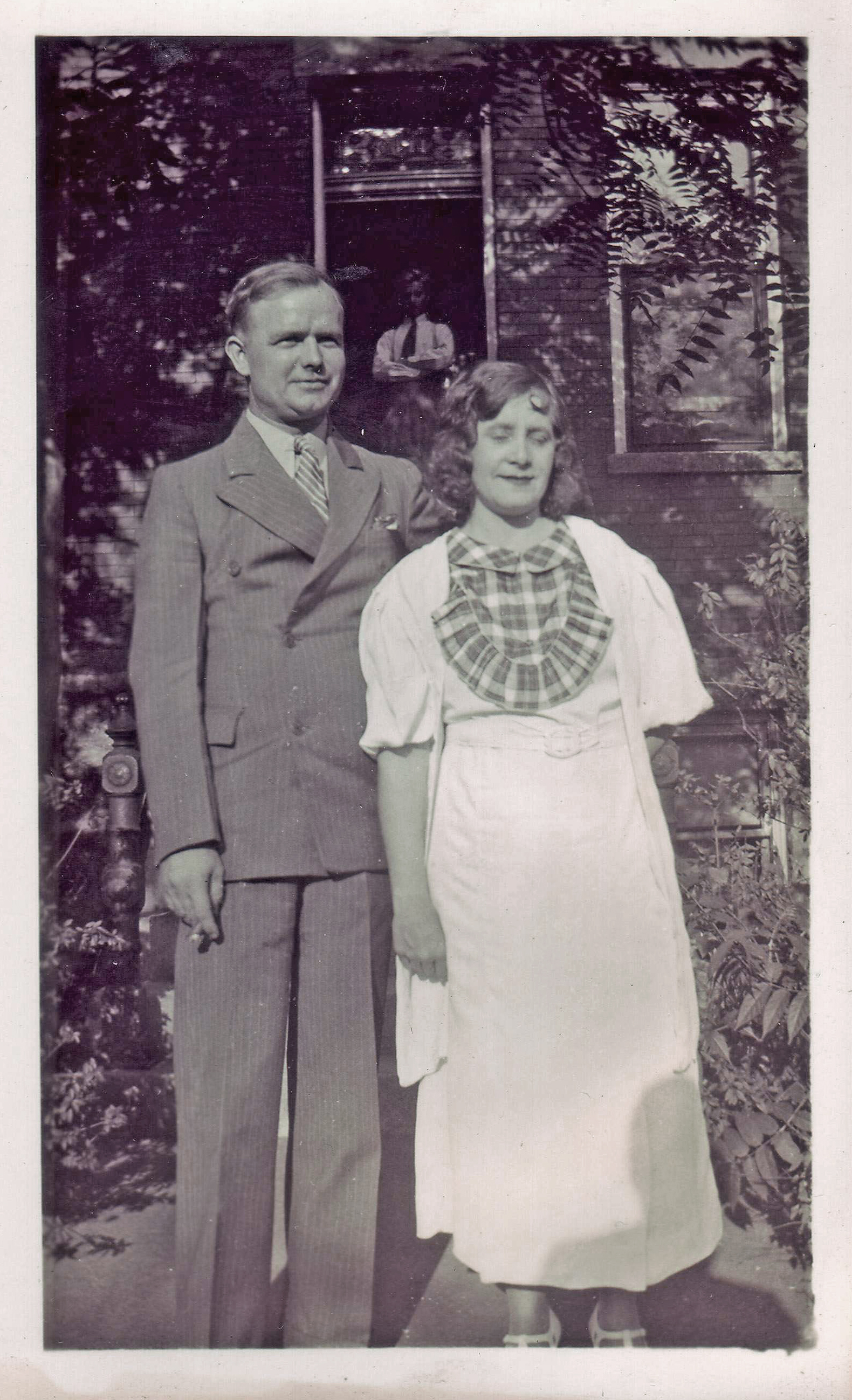
No, it wasn't a mistake. It was the clerk's attempt to deal with the father of the child whose own identity was still in flux (Petersen was evolving into MacLaughlan with a few spelling hiccups along the way). The godparents actually pointed to the mixed familial background. The child's step-grandfather Thomas Mikkelsen was married to the child's paternal grandmother, Catherine Petersen Mikkelsen. Catherine's daughter (and paternal aunt of the child), Marie Petersen, just sixteen years old, was one of the godparents. The mother's brother, William Louis (or Louis William) Jatho was another godparent. All were part of the family and all those surnames had something to contribute to the baby's family history.
It took several years of research (census, Chicago vital records, and other documents), plus interviewing other family members, to get to the nub of the story: the father, Alva Elwood MacLaughlan, had been born Alfred Emil Petersen. His sister Marie was a close family member. So was William/Louis Jatho, brother of Marie Jatho MacLaughlan, whose son this was. How Alva (a Chicago native) and Marie (born in Charleston, South Carolina) came together is not known. There are no photos of the couple from this mid-1910s when they courted and married. Later photos show a self-satisfied Alva and Marie (eyes closed, faint smile), with the teenage subject of this certificate glowering in the background of the photo. It doesn't appear to be a family happy to share whatever secrets they had.
Sometimes people don't tell you what you need to know. That's when you focus on the documents, and try to hear the story that way.
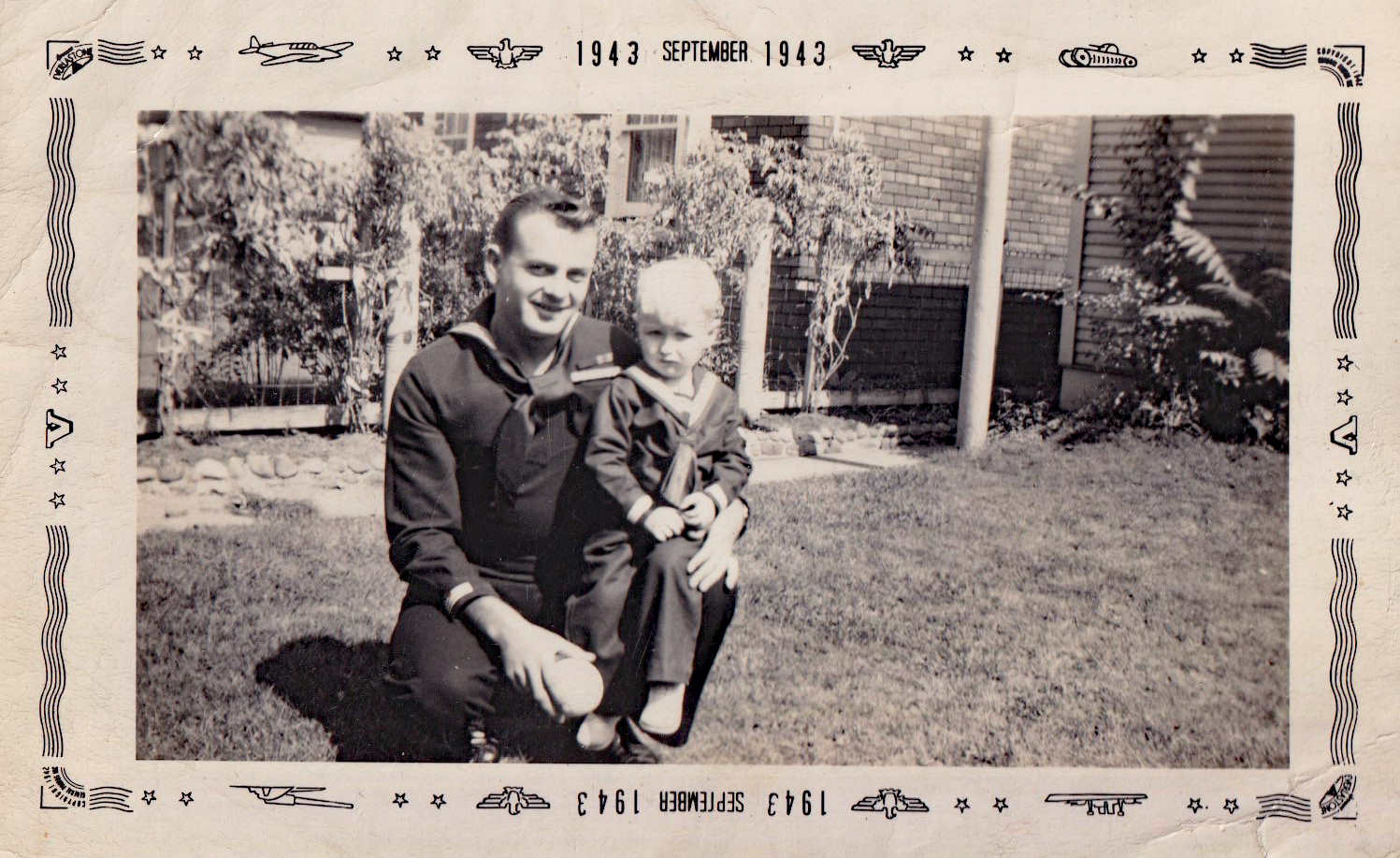
Leo (Leon) Frank Skiba
Leo Skiba was a maternal uncle, married to my mother's sister Lolus Bruns. I didn't know until discovering this photo in my cousin's collection that Leo had been a part of the family even before they were married. Here he's pictured with toddler Ted Zeltes, later Maynard, a cousin of Lolus and her siblings. These wartime photos were great for accurate dating of the image.
Lolus was the youngest child of George Henry Bruns and Bertha Gohr Bruns. Bubbly and vivacious, she apparently dated an infantryman called Pete Ramirez because her mother Bertha kept a photo of the couple in her album. But her long-term spouse turned out to be Leo, whose Navy career was always a source of pride to his family, He was a Pearl harbor survivor although it wasn't something he talked about to his family.
Leo's roots were in McKeesport, Pennsylvania where his Polish immigrant parents settled in the early 1900s. Michael Skiba was originally from Wesowa and Teresa Baran from Rzeszów. For some reason Teresa and Leo (called Leon then) travelled to Wesowa and returned to the U.S. in 1923, Teresa with a new baby called Helena-Josefa who was born in Poland.

The typed passenger list mistakenly listed Leon as being born in Poland too, although "U.S, born" is overwritten in dark pencil on the manifest. There was still some confusion in the 1930 U.S. federal census which also reported Leo's birthplace as Poland. But an email from Jim Masini of Our Lady of Lourdes in Chicago stated: "Our records indicate that Leo Skiba, son of Michael Skiba & Theresa Baron, was baptized at St. Mary's, McKeesport, PA on Nov. 18, 1917." So that's probably the most accurate information we have, although we note that it does say "baptized" and not "born." But other corroborating evidence exists: McKeesport is the birthplace for Leo as reported on collections such as the U.S., World War II Draft Cards Young Men, 1940-1947, the U.S. Social Security Applications and Claims Index, 1936-2007, and the Pennsylvania, U.S., Veteran Compensation Application Files, WWII, 1950-1966.
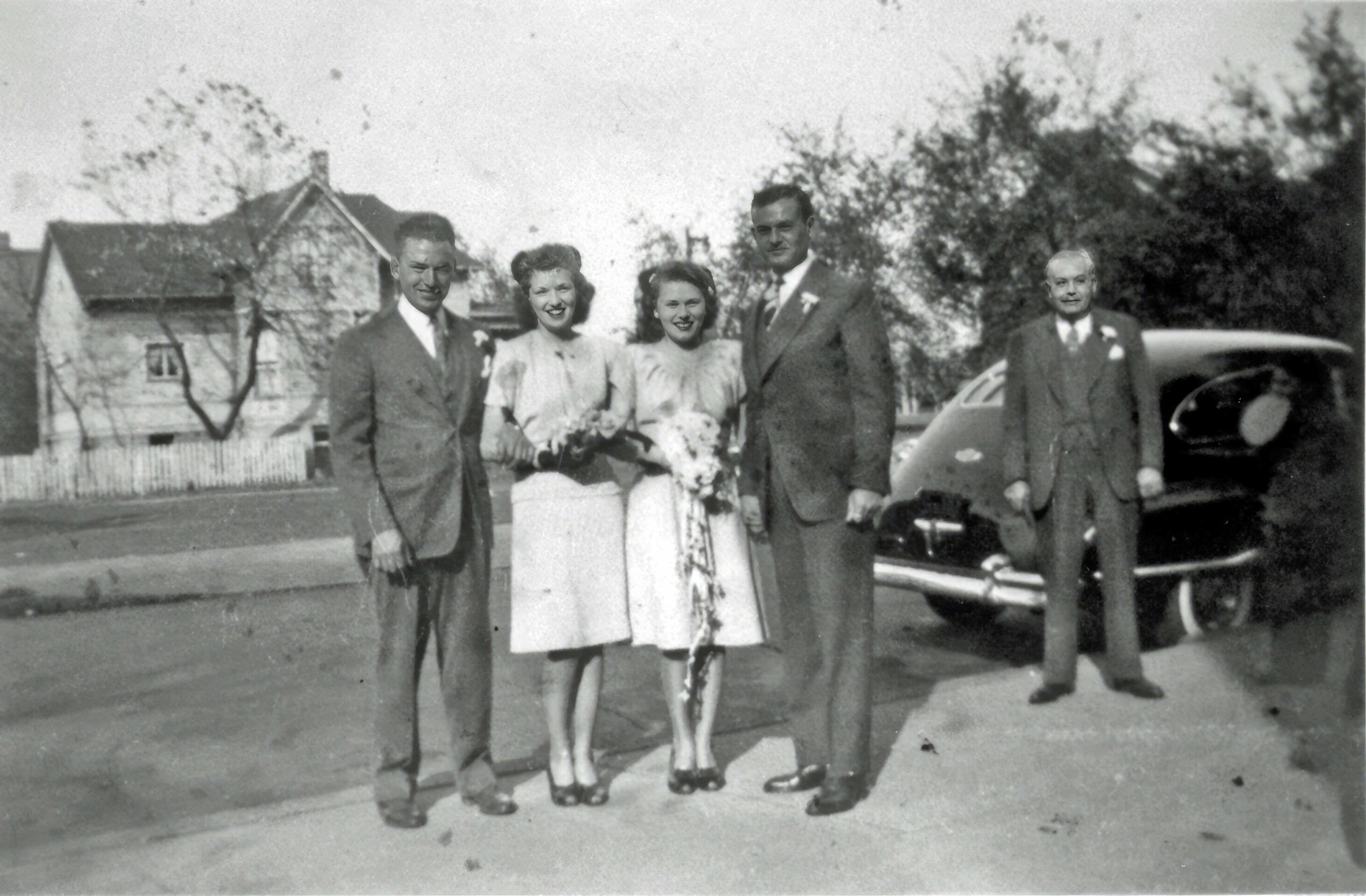
Leo and Lolus married on October 13, 1945 at Our Lady of Lourdes at Leland and Ashland in Chicago, which explains why this church could verify Leo's baptism: he'd obviously had to provide a copy of his certificate for the marriage to take place. Leo had been discharged from the Navy less than a month before the wedding, and he and Lolus relocated to Southern California (with Lolus' sister Lorraine and recently-widowed mother-in-law Bertha Gohr Bruns). They set up housekeeping first in a hotel room on Valley Blvd. (post-war housing was difficult to find) and eventually in a little stucco home on Alessandro Street in Temple City.
It was an idyllic location. The landscaping was lush and the back yard resplendent with plum trees. Both Leo and Lolus worked. Leo was fond of popular music and meeting up with Navy pals. Lolus had artistic tendiencies and her sketches were framed on the walls of their home. They had no children of their own but were devoted to their nieces whom they visited regularly.
Tragically, the couple were involved in an auto crash one night in 1964 after midnight when a stalled car blocked the road. Lolus succumbed to her injuries a few days later. Leo survived. His life was never quite the same without the woman who was clearly the love of his life. He was subsequently married to a Frances Kasmarik, a relationship that lasted a year, and later, more permanently, to Frances Gibbons, a liaison that proved to be more stable and long-term. Leo died in 2005 and was buried with Navy honors at Riverside National Cemetery in Southern California.
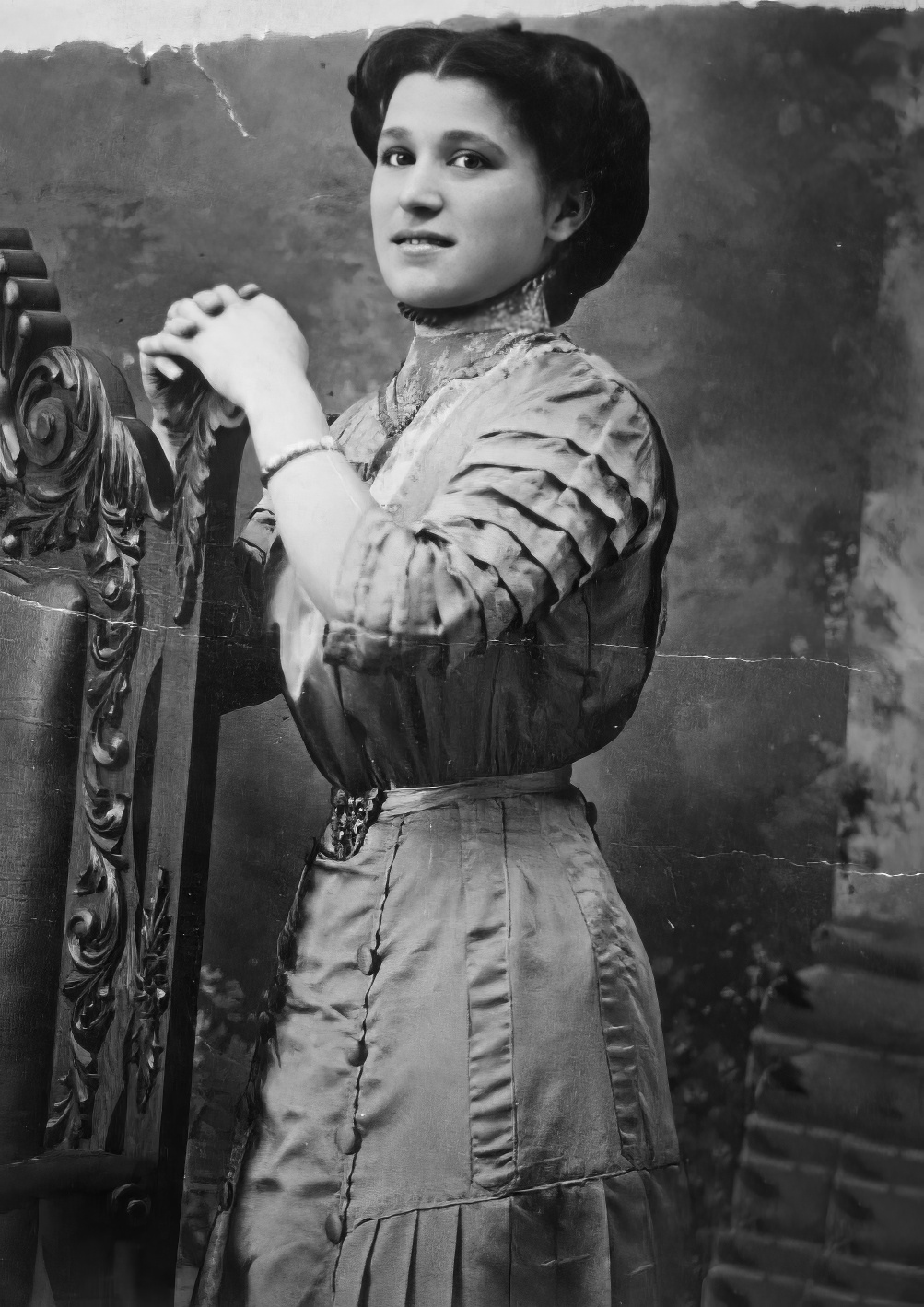
Hertha Alwine Louisa (Bertha Hulda, "Birdie") Gohr, c. 1908
Bertha Gohr Bruns was my maternal grandmother. She lived with my family for six months out of the year until 1964, when she moved in full-time and permanently
She was old-fashioned in a number of ways. Her handwriting was Germanic, her spelling whimsical. Her background included her German-born parents, who spoke German at home with their seven living children, and a little Polish, which wasn't unusual in the area where Bertha's parents were from or the neighborhood where they lived in Chicago. Odd phrases came to her mind: "sveenya posgoonya," apparently a term of endearment to her grandchildren but it meant "dirty little pig," not the most affectionate image. Why she used it is anyone's guess. Perhaps her relatives in Chicago used it with her own family. She retained an ability to converse in German all her life and would enthusiastically swear at her television set when commercials she disliked punctuated her favorite shows.
Bertha was born with a cumbersome name, Hertha Alwine Louise Gohr. Alwine was the name of a maternal aunt, Louise another aunt's name. She never liked Hertha as a name and changed it to Bertha Hulda at one point (Hulda was another aunt!), but was commonly known as Birdie by her friends and relations.
In this photo Bertha was at her most fetching, wasp-waisted, flirtatious, almost glamorous. She was the middle daughter in the family, born in 1886, probably twenty-two years old here and not yet affianced to her future husband George Henry Bruns.
That relationship was itself a problem, although her younger sister Margaret (also known as Alma) had the same challenge: both married Catholic men, although they were brought up Lutheran. Alma had to go through months of conversion training to marry (at the age of fifteen) her husband Frank Meyers in 1907.
Bertha had no such luxury. Her marriage required a certain amount of "hurry-up" due to the sooner-than-expected arrival of her first child, Bernard. George Bruns and Bertha Gohr were married in August 1911 and Bernard's birth was in November of that same year. Most documents don't reveal this (someone ordered a transcription of their marriage certificate which indicated that the marriage was in 1910 but Cook County clerical records reveal that it happened a year later). Not a problem, such things happen. But the situation may have contributed to the fact that the couple retained alliances to their own religions and never fully integrated them.
As a widowed grandmother (her husband George died in 1945), Bertha lived with her two daughters Lorraine and Lolus; visited her sons Bernard and George (but never lived with them); took the train to Chicago to see her sisters Anna, Ella, Carrie, and Minnie; had a contentious relationship with her youngest sister Alma, who lived in San Gabriel. She was a terrible but earnest cook, an excellent crochet artist, generous to a fault with her limited funds, fond of her sons-in-laws, devoted to her grandchildren.
